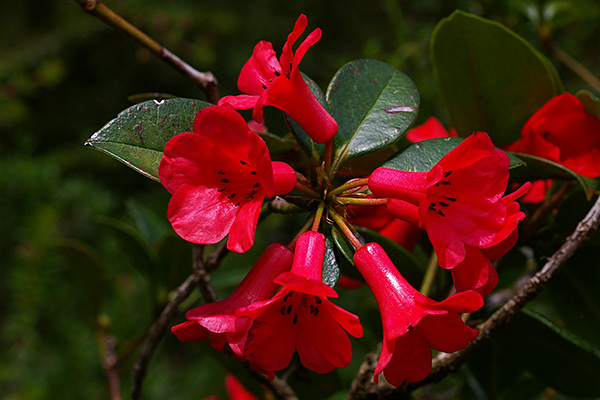General Description:
The plant family Ericaceae (heaths and heathers) is widespread in many parts of the globe, particularly Europe and South Africa. It contains a number of widely cultivated plants such as Erica, Rhododendron and Pieris.
Most of Australia’s members of the Ericaceae belong to the subfamily Epacridoideae, which was formerly classified as a separate family – the Epacridaceae. Rhododendron, however belongs in the subfamily Ericoideae and it is the only genus in that subfamily that occurs in Australia.
Rhododendron is a large genus of over 1,000 species but only one occurs naturally in Australia.
The taxonomy of Rhododendron lochiae has been a source of confusion in recent years. Research into the taxonomy of collected specimens proposed that there were in fact two distinct species. The research further suggested that the name “lochiae” had been originally applied in 1887 to the less common of the two species and that, therefore, the name R.lochiae had been incorrectly applied to most of the plants in common cultivation.
In 1996 an attempt was made to overcome the confusion by applying the name Rhododendron notiale to the less common plant so that R.lochiae could be retained as the name of the commonly grown species. However, as this involved a change to the ‘type’ specimen, it was rejected by the International Union of Biological Sciences. Subsequently, the more common species (and the form most seen in cultivation) was described as a new species called R.viriosum and the name R.lochiae was retained for the less common species (as originally described). This classification is accepted by the Queensland herbarium but the Australian Plant Census currently recognises only one Australian species of Rhododendron (R.lochiae) – both R.notiale and R.viriosum are regarded as synonyms of R.lochiae.
For a more detailed discussion of this research, see the following articles from virera.net (pdf format):
- Craven, L. & Withers, R.M. Old is new and new is old: Rhododendrons lochiae and notiale http://www.vireya.net/archive/CravenWithersAusJ96.pdf, from ‘The Rhododendron’, Journal of The Australian Rhododendron Society, Vol. 36, 1996
- Craven, L. Playing with names: Rhododendrons lochiae and viriosum and the dark side of taxonomy, from ‘The Rhododendron’, Journal of the Australian Rhododendron Society, Vol. 43, 2003
R.lochiae is a small shrub which, in nature clings to cliffs by sending roots down into crevices in the rocks. The species has also been described as growing as an epiphyte (ie. on trees).
The species has glossy, oval-shaped leaves about 75mm long. The deep red, bell shaped flowers occur during spring and summer, the exact flowering time depending on the geographical location where the plant is grown. The flowers are about 50mm long by 30mm across and occur in terminal clusters of up to six.
R.lochiae can be grown successfully in a moist, shaded, well drained position in temperate climates but can be difficult to maintain in tropical areas at low altitudes. It is damaged by frost. The species also makes an excellent plant for growing in a container. As it is not especially fast growing, it does not require annual re-potting.
Propagation is relatively easy from cuttings. Like all members of the Ericaceae, R.lochiae forms very fine roots which can be easily damaged on repotting. Striking cuttings in individual small tubes is recommended. Sometimes plants in cultivation will set seed in small pods. The species can be propagated from seed using conventional seed raising methods.
* EPBC Act = Environment Protection and Biodiversity Conservation Act 1999;
ROTAP = Rare or Threatened Australian Plants (Briggs and Leigh, 1988)
For further information refer the Australian Plants at Risk page

Tubular shaped flowers of Rhododendron lochiae
Photo: Brian Walters
 Australian Native Plants Society (Australia)
Australian Native Plants Society (Australia)